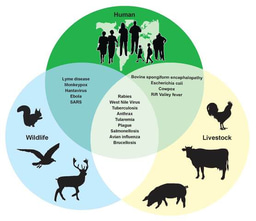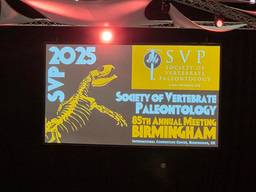Highlights of the BMC Series - February 2025
Published in Healthcare & Nursing, Genetics & Genomics, and Public Health

BMC Genomics - Distribution and phylogenetic analysis of porcine parvoviruses in the wild boar population of Russia
Wild boar (Sus scrofa) are native to Russia, as well as across almost all of mainland Europe. They can serve as a reservoir for various infectious agents, including zoonotic pathogens.

Porcine parvoviruses (PPVs) are small, non-enveloped viruses which are found in wild boars and are pathogenic. For example, PPV1 causes reproductive losses in pig production with clinical signs including embryonic death and infertility. A study carried out in Russia aimed to investigate the prevalence and genetic diversity of PPVs (PPV1-PPV7) among wild boar populations. The authors sampled 108 free-living wild boars from 3 regions in Russia between 2021 and 2024. The authors extracted nucleic acid from the samples and carried out qPCR. Sanger sequencing and phylogenetic analysis were also carried out.
The authors found that all seven PPV species were detected among wild boars, with at least one of them observed in around 91% of the boars. The phylogenetic analysis of PPV1 revealed that most of the isolates were assigned to the group with 27a-like strains from Europe. Novel PPVs isolates found were distributed in numerous clusters with isolates from wild boars as well as domestic pigs from different countries.
The study highlighted the need for future research to look at the circulation of PPVs in both wild boar and domestic pig populations, and the evolution of PPVs and the direction of infection transmission routes.
BMC Pregnancy and Childbirth - A scoping review of digital technologies in antenatal care: recent progress and applications of digital technologies

Antenatal care (ANC), also known as prenatal care, is crucial for promoting the health and well-being of pregnant individuals and their unborn children. The compliance, effectiveness, and accessibility of ANC services are influenced by a number of factors such as healthcare infrastructure, knowledge and socio-demographic characteristics. Digital health services have emerged to address these challenges and have significantly advanced maternal and foetal health outcomes by enabling real-time monitoring, personalised care, and improved access to critical information and support.
This scoping review aimed to assess the features and effectiveness of digital health modalities in ANC with a focus on their applicability, outcomes and recent advancement. After screening was carried out using predefined inclusion and exclusion criteria, 126 studies were eligible for data extraction.
The authors concluded that digital health technologies have proven to be transformative in ANC with tools (such as mHealth apps, wearables and tracking devices) effectively supporting communication, monitoring and education. Although they highlight that in-person visits remain essential for managing high-risk pregnancies and complex medical conditions. The integration of digital interventions with physical visits provides a holistic approach to optimise clinical outcomes.
BMC Nutrition - Application of Nordic Keyhole and Nutri-Score for assessment of nutritional quality of plant-based dairy analogues

In recent years the interest in plant-based dairy analogues (such as oat, almond and soy), has increased and the market is estimated to continue growing in the future. This has been driven by medical reasons, such as lactose intolerance, or for lifestyle choices including veganism and animal ethics concerns.
Given this projected increase, it is necessary to assess the nutritional quality of these analogues and the role of Front-of-pack Nutrition Labelling (FOPNL) schemes. In Europe, the two main voluntary FOPNL schemes are Keyhole and Nutri-score.
In this study, the authors applied Keyhole and Nutri-Score criteria to plant -based dairy analogues (milk, yoghurt, cheese, cream, fat spread and ice cream analogues). Nutritional data were collected from 222 plant-based dairy analogues available in the Swedish market during 2022. Product information, ingredient lists and health and nutritional claims were collected from the manufacturers’ websites for all plant-based dairy analogue groups. This information was used to assess these analogues against the Keyhole and Nutri-Score.
The study found that there was a significant variability in the eligibility of plant-based dairy analogues for Keyhole and Nutri-Score labelling. The assessment based on Keyhole and Nutri-Score criteria demonstrated that the interpretation of the nutritional quality within the food category might depend on the type of FOPNL scheme. In addition, the Keyhole and Nutri-Score often diverged in classifying most plant-based dairy analogues as products with optimal nutritional quality. The authors highlighted the need for comprehensive assessments and complementary labelling systems to guide consumer choices across plant-based dairy analogues.
BMC Veterinary Research - Associations between body composition, metabolic mediators and osteoarthritis in cats

Osteoarthritis (OA) is a common joint disease in cats and its prevalence rises steeply with age. In most clinical cases of OA in cats, the initiating cause remains unknown. It is widely known that obesity is a risk factor for human OA but in cats, it is unclear if excess body fat is a risk factor for OA.
In this study, the authors collected data from 72 cats which underwent clinical examination, an orthopedic examination, blood sampling and whole-body computed tomography (CT) examination. Using the whole-body CT images, the presence and severity of OA was determined.
OA was commonly detected with whole-body OA scores being higher in more overweight cats compared to leaner cats. A relationship between increased body fat and total OA load in cats was found; a larger body size, in combination with increased body fat, could be an additional predisposing factor for cats developing OA.
The authors highlighted that their findings suggest it may be beneficial to keep cats lean in order to reduce the risk of OA, particularly in larger sized cats. Further research into the role of metabolic mediators in the pathogenesis of feline OA is warranted.
BMC Digital Health - Evaluation of a novel interactive virtual reality environment for mindfulness skills training
.jpg)
Mindfulness meditation has become an area of interest in recent years in both scientific research and popular culture as a potential tool for improving overall wellbeing, including reducing anxiety and depression. Using virtual reality (VR) technology in meditation practices has gained attention from researchers with clinical experts previously agreeing that VR was a feasible and acceptable format for mindfulness.
The authors of this pilot study sought to evaluate the impact of an interactive VR environment-based mindfulness meditation on mindfulness skills development among undergraduate health science students.
The study found a significant improvement of just under 5% in mindfulness score for the VR cohort compared to the control cohort. The VR environment had enhanced enjoyment of the mindfulness practice and led to improvements in state mindfulness scores. Overall, the students were able to escape from reality and be immersed in a relaxing environment which increased adherence and motivation to practice.
The authors highlighted future research should evaluate the long-term impact of VR-based training on mindfulness practice and whether the environment could be used for live guided mindfulness practice within VR.
Follow the Topic
-
BMC Digital Health

BMC Digital Health considers research on all aspects of the development and implementation of digital technology in both medicine and public health, such as mobile health applications, virtual healthcare and wearable technology, as well as the role of social media in digital health.
-
BMC Nutrition

BMC Nutrition is an open access, peer-reviewed journal that considers articles on all aspects of nutritional sciences.
-
BMC Pregnancy and Childbirth

This is an open access, peer-reviewed journal that considers articles on all aspects of pregnancy and childbirth. It welcomes submissions on the biomedical aspects of pregnancy, breastfeeding, labor, maternal health, maternity care, trends and sociological aspects of pregnancy and childbirth.
-
BMC Genomics

This is an open access, peer-reviewed journal that considers articles on all aspects of genetics, genomics and proteomics.
-
BMC Veterinary Research

This journal considers articles on all aspects of veterinary science and medicine, including the epidemiology, diagnosis, prevention and treatment of medical conditions of domestic, companion, farm and wild animals, as well as the biomedical processes that underlie their health.
Related Collections
With Collections, you can get published faster and increase your visibility.
Genomics of invertebrates
Invertebrates inhabit a wide range of habitats and represent a large array of species including insects, mollusks and crustaceans. Thus, they play crucial roles in ecosystems and are essential for ecological balance. Advances in genomic technologies such as high-throughput sequencing and transcriptomics have opened new avenues for understanding the genetic basis of invertebrate's biology, evolution, and interactions with their environments. As more and more genomes are being sequenced and our ability to analyze these genomes improves, so does our understanding of the intricate biological mechanisms that govern invertebrates' lives.
Understanding the genomics of invertebrates is critical for various fields, including agriculture, environmental conservation, and human health. For example, sequencing the genome of the mosquito Aedes aegypti, a major vector of diseases such as dengue, Zika, and Chikungunya, has provided insights into its insecticide resistance and behaviour, aiding in the development of targeted control strategies such as gene-editing technologies. Similarly, studying the genetics of the honeybee (Apis mellifera), a key pollinator for global agriculture, has helped to understand factors affecting colony health, including pesticide sensitivity and disease resistance. As invertebrates form the foundation of many ecosystems, research on their genomics should be at the forefront of strategies to protect our environment and its ecological balance.
Topics of interest include, but are not limited to:
•Genome organization and evolution of invertebrate species
•Genomic insights into insect vectors and their parasites
•RNA-Seq applications in invertebrate research
•Transcriptomics studies on invertebrates’ ecological interactions
•Functional genomics of invertebrates’ immune responses
•Evolutionary genomics of adaptation to extreme environments
•Metagenomics of invertebrate-associated microbiomes
•Genomic approaches to study invertebrate behaviour
•Population genomics and conservation genetics of threatened invertebrates
•Genomic resources for biocontrol agent development
All manuscripts submitted to this journal, including those submitted to collections and special issues, are assessed in line with our editorial policies and the journal’s peer review process. Reviewers and editors are required to declare competing interests and can be excluded from the peer review process if a competing interest exists.
Publishing Model: Open Access
Deadline: Dec 24, 2025
Genomics of microbiomes
The study of microbiomes has emerged as a dynamic field at the intersection of genomics, ecology, and health sciences. Microbiomes encompass the diverse communities of microorganisms, including bacteria, viruses, and unicellular eukaryotes, residing in various environments, such as the human body, food, soil, and aquatic systems. Understanding the genomic makeup of these microbiomes is crucial for unraveling their complex interactions with hosts and the environment. As advances in sequencing technologies, including single molecule sequencing, metagenomics and single cell omics, continue to evolve, researchers are better equipped to explore the rich genetic diversity (including pangenomes and epigenomes) and functional capacities of microbiomes across different ecosystems.
Investigating the genomics of microbiomes is pivotal for addressing critical questions in ecology, health, disease, and environmental sustainability. For instance, recent breakthroughs in the field have illustrated how microbiomes influence human health, from their roles in metabolism and immune function to their impact on mental health. Furthermore, understanding the genomics of environmental microbiomes can provide insights into biogeochemical processes and ecological resilience. As we deepen our knowledge of these microbial communities and develop computational biology methods to model their functionality, we stand to enhance our ability to harness their potential for applications in medicine, agriculture, and environmental management.
Future research in this area holds the promise of transformative advances in our understanding of microbiomes. The integration of multi-omics approaches, combining genomics with transcriptomics, proteomics, and metabolomics, may lead to a holistic view of microbial community dynamics and their functional implications. Additionally, developments in artificial intelligence and machine learning could further accelerate discoveries, enabling the identification of novel microbial functions and their roles in health and disease. As we continue to explore these intricate relationships, we can anticipate innovative strategies for harnessing microbiomes for therapeutic and environmental applications.
Topics of interest include, but are not limited to:
•Genomics and epigenomics of host-microbe interactions
•X-omics studies in environmental and host-microbiomes
•Advances in genomics of unculturable microorganisms
•Genome-guided development of synthetic microbiomes and consortia
•Microbiomes and environmental resilience: a genomic perspective
•The human microbiome: genetic diversity and functional potential
•Microbial adaptation and evolution in changing environments
•The role of microbiomes in antibiotic resistance and pathogenesis
•Computational and AI-driven methods for microbiome genomics
•Microbiome applications in sustainable agriculture and environmental management
All manuscripts submitted to this journal, including those submitted to collections and special issues, are assessed in line with our editorial policies and the journal’s peer review process. Reviewers and editors are required to declare competing interests and can be excluded from the peer review process if a competing interest exists.
Publishing Model: Open Access
Deadline: Jan 07, 2026





Please sign in or register for FREE
If you are a registered user on Research Communities by Springer Nature, please sign in